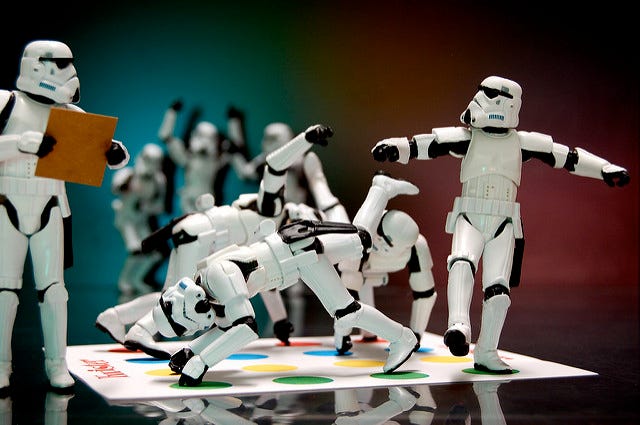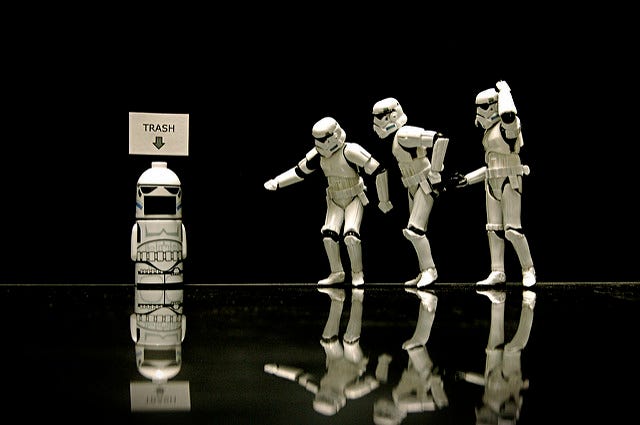
The Biggest Waste in Agile
And it’s not waiting…
Once upon a time, all development was done following a waterfall approach, one process sequentially following the previous.
Ducks in a row….
It was like a game of pass-the-message where the first person whispered a secret message in the next person’s ear. Each subsequent person whispered what they heard in the next person’s ear, until the last person had to relay the message to the entire group.
Usually, it results in laughter when the original message gets to the other side so distorted, often not even remotely the same as the initial intention.
Like little ducks in a row, waterfall development similarly contained each dependency in a well-defined box, one following the other. Planning was done by the project managers, requirements by the business analysts, design by the designers, and so it continued until the product was finally ready for the customer.
It never really did work though, and agile was born.
The empire strikes again
Agile was not like anything before. It didn’t have a recipe you could follow like all the previous methodologies.
There are no detailed guides. There are only a set of four values, written in a it-depends kind of way. Open to the interpretation of each unique reader.

Image 2009 title “Four Storms and a Twister” by JD Hancock available on Flickr. Some rights reserved, no changes made to the original image.
No rules, no defined processes, no hard-and-fast anything.
Rather, it is like a game of Twister, where everything is inter-connected with different people from distinctly different disciplines working together to deliver an increment of the product.
Letting go of the defined structures we are so used to often looks as chaotic from the outside, yet, the value of the method is the break-down in silo’s as a result of the interconnectedness. The teams that have the bodies entangled on the floor, are the ones to see the fun and purpose in the game.
The single biggest strength of agile is that there are to be no more secrets between different teams. No more whispering the message hoping that the next team won’t hear it properly so that you can sit back and have a laugh at the end of the day.
Agile was designed to break down silo’s and enable human-to-human communication.
Yet, we failed miserably in most cases. We threw away the rules and processes and red tape, but we didn’t work on the one thing that agile was attempting to resolve. Cross-functional communication.
Which brings me to the title of the post — namely the biggest waste in agile.
The biggest waste in agile, is the loss of information between different teams or functions.
Each time you speak to someone other than the person directly affected, you dilute the message. The more layers between the original, face-to-face message and the recipient, the more diluted it becomes.
Each time you don’t speak to someone else when you disagree because you would rather agree than risk the discomfort of disharmony, a piece of the puzzle is hidden, making it hard to build a complete picture.
Each time you speak so much that no-one else has the energy left to sit for another hour and listen, you inhibit the creativity and growth of the entire team and cut off a part of the picture that could have made it awesome.
Each time you don’t ask when something clearly doesn’t make sense, because it comes from an authority figure or a different function, you’re allowing mistakes to creep in keeping the picture from becoming awesome. It’s like seeing a puzzle piece being put in the wrong place but saying nothing.
Each time you don’t point out a dysfunction in the team because you’re afraid that you’ll be fired, or ridiculed, or hurt someone else’s feelings, you’re enabling the dysfunction to grow bigger. You consent to the dysfunction by refraining to voice your opinion.
Each time you do something that you’re not proud of, or don’t believe in, only because you’re tired of fighting for the product or the customer, you inhibit the entire team’s success. And that includes you.
Trash Talk
So let’s talk about trash…
People make mistakes. All of us. The smallest, and the biggest. None of us are perfect, and if we were, there would be little need for us to communicate. But communication and social connection is a big reason why you’re working in an organization and not being a solo-preneur, so don’t discard communication as a not-so-important issue.
Don’t refrain from doing it differently only because that’s the way you’ve done it before. The power is in your hands and change starts with you.

Image 2010 title “Trash Talk” by JD Hancock available on Flickr. Some rights reserved, no changes made to the original image.
So what can you do to reduce this waste?
1 — Equal speak-time
The easiest strategy to start with is to bring equality to the airtime in any meeting.
As the agile coach, observe the team and after each meeting, show them a breakdown of how much each person spoke during the meeting. No judgement. Simple raise the awareness.
2 — Speak up
Much harder, it takes courage to speak up and say when you see a dysfunction in the team, especially if it comes from the leader.
But speaking up is not the same as criticism.
Criticism is trying to make someone else look bad. Speaking up is living in integrity. Being true to yourself, while having the best interest of the group in mind.
If you don’t believe in what you are about to say, and if you don’t have the best interest of the entire group in mind — not only your own self-interest — it’s criticism. Keep quiet.
Go do your homework, gather the facts, and ask yourself whether what you are about to say is to look important, or to add value.
3 — Support
Two voices are stronger than one. When someone in the team raises an issues that you feel strongly about, strengthen their voice and support them. It’s scary to question an authority figure.
But, it’s much more scary being the authority figure. An authority figure is responsible for an entire team’s wellbeing, while most team members, take the monthly salary for granted. They are often the most vulnerable person in the group, and far outnumbered by the team.
Support. Don’t attack.
4 —Attempt to understand
You can’t support someone if you don’t even know what their day consists of, or what challenges they have to face. Just because it’s not your job, doesn’t mean you can’t add value.
Try to understand what your colleagues need or do. I often see how people switch off when the discussion topic is not directly related to them. This is harmful and counter-productive.
The better you understand what the other person in your team does, the easier you will make their job, and the easier your job will become as a result.
5 — Question your intent
Why are you doing or saying what you are doing? Are you trying to look good? Or are what you are about to say important and in the best interest of the entire group?
Does the whole team need to hear what you have to say? Or can you have a one-to-one after the meeting?
Conclusion
The biggest waste in agile is the loss of valuable information as a result of bad communication within teams.
Communication is not the same as talking. You don’t communicate with anyone by speaking. You communicate when there is equal speaking and listening.
Originally published on Medium: https://everydayagile.com/the-biggest-waste-in-agile-e8925c3ec512
